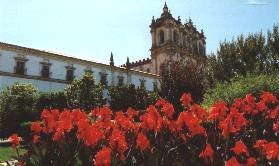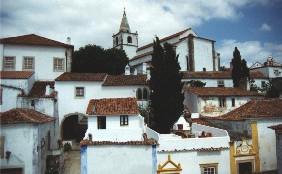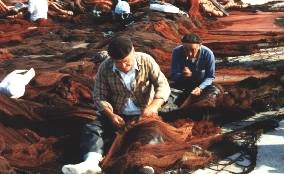 |  |  |  |




 |
Places of Interest on the Silver Coast, Portugal. |
 |
Portugal is the westernmost country of Europe and has a population of 10.5 million people and is the nation with which Britain enjoys its oldest alliance dating back to the late 1300’s. Stretching from Lisbon to Fiqueira da Foz, Portugal’s Costa de Prata (Silver Coast) is a gem of largely undiscovered beauty and gets its name from the effect of the sun on the waves of the Atlantic Ocean. Unlike its more famous and populous cousin in the south of the country here you can discover pretty villages and a real Portuguese way-of-life amongst stunning coastal scenery fringed with the best beaches in Europe. Because much of this area of Portugal remains undiscovered by the mass tourism market you can guarantee a beach to yourself even in the height of the season if you are prepared to drive and walk a little way. The Praia d’el Rey championship golf course and its luxurious accommodation and superb beach happily nestle side-by-side with the ancient, picturesque charm of medieval Óbidos whilst our accommodation at Foz do Arelho offers access to the beauty of the Óbidos lagoon and the lively bars and restaurants around its shores. Lisbon is an hour way and not to be missed. It is a beautiful city with a richly deserved reputation for the warmth of its welcome and is recognised as one of the most sophisticated capital cities. Like most of Portugal the Silver Coast comprises mainly small towns and villages; 3 million of Portugal’s population are in the two major cities of Lisbon and Porto with the remainder spread across the country. Consequently overcrowded roads and oppressive cities are not to be found. Small town and village life may move at a different pace to that which you are used to at home and adjusting to this healthy pace is part of the pleasure of being on holiday. Visits to the fascinating towns and villages of this region are made on uncrowded roads and offer rich rewards. Fátima is an easy drive as are Alcobaça and Tomar. Eating out is both affordable and satisfying; there are top-class restaurants to sample as well as very reasonably priced eating-out. Tempting sea-food is a speciality and can be enjoyed with a chilled bottle of white from the region. You will find modern-day Portuguese people to be exceptionally friendly and visits to the many non-touristy destinations which abound in our area immensely rewarding. Below is some information on some of the many places which you can visit easily from your holiday accommodation and which make this area so fascinating. If you want you can soak up the sun on one of countless beaches; play golf on a stunning links course or take in the history and culture with which this area abounds - the choice is yours when you book a villa rental holiday with Portugal Holiday Destinations . |
Alphabetical listing of just a few of the places to visit within easy reach of Praia d'el Rey Golf Course, Caldas da Rainha and Foz do Arelho, starting with the World Heritage town of Alcobaça. |
Alcobaça The magnificent and austere Cistercian Abbey at Alcobaça dominates the centre of the town. The austere aspect is continued within the church in which are the tombs of King Pedro 1 and Ines de Castro, his murdered mistress. Beyond the church lies the peace and quiet of the “Cloister of Silence”. In contrast, within the Abbey is the massive kitchen with a running stream specially diverted to pass through as a supply of fresh water. The open area of the kitchen chimney is large enough to take a whole ox for roasting. The surround to the sacristy doorway is an outstanding example of Manueline decoration. In 1794, Lord Beckford visited the Abbey and commented that he found some 300 monks “living in a very splendid manner”! It is now a World Heritage Site. |
| Batalha Batalha, by comparison offers an example of the baroque and elaborate Manueline architecture which is the Abbey of Santa Maria da Vitória and which is now a UNESCO world-heritage site. Commenced in 1388, and later added to and enhanced by various Portuguese Kings over these next two centuries the cathedral is an outstanding example of combined Gothic and Manueline architecture. Under its naves lies some of Portugal’s most historic personalities during that period. Here you will find resting the tombs of João I, his English wife Philippa of Lancaster, and their famous offspring, Prince Henry the Navigator whose efforts and determination helped to explore the then unknown world. In the Chapter house lie two unknown soldiers from World War I thus giving the Abbey a military relationship to the 20th century. |
| Caldas da Rainha Caldas da Rainha means “the queen’s baths” and was christened thus when Queen Dona Leonora came across locals bathing in the mud at the side of the road so as to cure their ailments. She became convinced of the therapeutic qualities of the local waters and founded what is now the oldest thermal hospital in the world. This still functions today when the plumbing is not playing up. Caldas is also renowned nationally for its locally-produced cakes and pastries - try the Pastelaria Machado opposite the entrance to the park if you have a sweet tooth. The daily flower and produce market really should not be missed as this is a fascinating and colourful insight into a way of life which is dying out. Much of the produce is grown locally and could not be fresher, being sold as it is by the same people who have planted and tended it. Otherwise Caldas is a good base for shopping and for necessities such as banks, post office, pharmacies etc. The park has a boating lake and a children’s playground and a café where you can sit under the shade of the trees and watch the world go by. The town is home to the region’s best restaurant - Sabores de Italia, close by the post office. |
| Cascais Cascais is an old fishing village which developed into a town rapidly from the 19th century when the royal family chose it as their summer residence. Today it is the residential area for the Lisbon jet-set and a favourite night spot for young people. |
| Coimbra Coimbra stands on the banks of the River Mondego. It is the traditional cultural centre of the country with one of the oldest and most prestigious universities in Europe. Here the fado, bohemian life, learning and tradition are maintained alongside the present day city which has retained it's fine monuments and architectural heritage. |
| Conimbriga Ruins The ancient Celtic settlement from which Coimbra took it's name, became a regional centre under the Romans. The remains at Conimbriga are probably the finest example of a complete Roman settlement in Europe. |
| Ericeira Ericeira is a fishing port that has retained many of the turn-of-the-century characteristics which it had when the last king of Portugal sailed into exile from there in 1910 at the time of the founding of the Republic. In or out of season it is a pleasure to sample the gastronomic delights of the restaurants overlooking the sea. Fresh fish, vegetables and fruit, as well as the savoury sausage baked in bread and a range of regional sweets. |
| Estoril Estoril is situated on the coast and protected by the Serra de Sintra. As a result, it has a very mild climate. A number of former monarchs and pretenders in exile lived here: Carol of Rumania, Umberto of Saboia, Juan de Bourbon (the father of Juan Carlos of Spain), Edward the VII the King who abdicated the throne of England to marry an American Mrs. Simpson, made his home near here in the Second World War. It is a popular residential area for the growing foreign community in Portugal. Just outside the town there is a lively night life and casino. |
| Evora The historic centre of Evora is also a UNESCO world-heritage site. Situated 130 kms from Lisbon in the Alentejo district Evora was settled by the Romans who knew it as Liberalitas Julia. There can still be seen the remains of the Temple of Diana, the only Roman architecture of its type remaining in Portugal and which, down the centuries, has been used variously as a brothel and a slaughterhouse after the Romans had moved on. In the middle-ages Evora was one of the more prosperous regions of the country and the vestiges of its wealth can be seen in the numerous monuments that can be visited. One of the more bizarre sights is the 15th century Capela de Ossos or Chapel of Bones which is lined with the remains of the monks who previously lived and worked there. There are a number of very good restaurants in Evora which make a suitable retreat when the Alentejan heat becomes too fierce. |
| Fatima Fatima welcomes millions of devotees a year who come to pray at the site of a miraculous apparition of the Virgin Mary here in 1917. Three shepherd children had a vision of Mary, who reportedly reappeared on the 13th of each of six subsequent months calling for peace in the world. On the day of the final apparition a crowd of over 70,000 people had gathered and claimed to witness the Miracle of the Sun, when illnesses and disabilities were cured amongst the onlookers and the sun appeared to shake and tremble in the sky. A vast white Basilica and esplanade were completed in 1953 as a shrine for the ever growing numbers of pilgrims flocking to the town. To this day pilgrims undertake a circuit of the shrine on their knees as penance or atonement and in supplication for God’s blessing. Fatima remains a strange mix of devotion and commercialism with many tourist shops selling a mind-boggling array of very tacky religious souvenirs. |
Foz do Arelho  Situated at the mouth of the north side of the lagoon Foz do Arelho has been a much-loved destination for the jaded Lisbon city-dweller. Leading inland from the enormous wave-pounded beach is the tranquil Obidos lagoon which in days gone by stretched as far as the fortified town. Now it is the place of work of many ‘clammers’ who extract the delicious local clams which can be found in the restaurants within the town. The beach-side bars offer views over the Atlantic and the lagoon and offer first-class service. Try the Sétima Vaga if you can get a table and enjoy the esoteric selection of music on offer! A wonderful place to watch the sunset. |
| Lisbon If you are visiting Lisbon we would suggest that you leave your car at the airport and get a cab into town. Cabs are plentiful and cheap and if you get one up to the highest point in the city at the Castelo São Jorge you can save yourself a wearying climb! Remember - it is always hotter in Lisbon. The views from the top over the Tagus estuary and the city are spectacular. Although Lisbon has become a major cosmopolitan destination it still retains some of the atmosphere of a village. It is very much a lived-in city and each bairro or district has its own identity. As you meander down from the castle you will come to the Alfama district with its narrow shopping alleys and shady corners. If you are looking for one of the most happening scenes in Europe for nightlife head for the Bairro Alto which is transformed at dusk into a pulsating area of chic restaurants and lively bars and clubs. A more contemplative and cooling time can be spent at the wonderful Oceanarium which is located in the Expo98 site on the banks of the Tagus. Excellent shopping under one roof is available at the vast Colombo Shopping Centre at Benfica. Your guide book will give you a much more comprehensive idea of what Lisbon has to offer. |
| Loures Loures is just to the north of Lisbon in a country area where small farmers of Arab origin grew fresh green vegetables. For many centuries it was a summer residence for wealthy Lisbon families. The town was the first to proclaim the founding of the Republic. It is proud of the lovely Palacio do Correio-Mor, one of the finest pieces of Architecture on the outskirts of Lisbon. |
| Mafra Mafra consists of two areas. The old town which grew up around a castle, the remains of which is almost lost amongst the houses. The 18th century part is relatively more recent. Developed in the shadow of the majestic monastery constructed by King Joao V. It was built with gold from Brazil and in fulfillment of a promise made for the birth of an heir to the throne. Thousands of men from all over the country were used to carry the necessary stone. This impressive building, monastery, basilica, and palace has fine views from the dome and small towers overlooking the game preserve and park. The town is well known for it's Sunday carillon concerts and traditional cakes. |
Òbidos Òbidos is a medieval walled town which enjoys a magnificent present-day state of repair as a result of its status as the traditional gift from Portuguese kings to their wives. The monarchy was overthrown only in 1910 and Óbidos reflects the benefits of its patronage until these relatively recent times. Within the walls are fascinating alleys which have become home to high-class handicraft and gift shops as well as bars and restaurants of repute. The town is a very popular stopping-off point for tourist buses from Lisbon so it might be a good idea to take advantage of being on the doorstep and make your visit in the early evening when the crowds have gone and you can enjoy the atmosphere at leisure. |
Peniche Peniche is Portugal’s largest fishing port and the industry dominates the town. It is great to take a walk along the sea wall before repairing to one of the many harbour-side restaurants for fresh fish cooked on a barbecue at the roadside. You won’t believe the price either. The fort at Peniche became a prison during the extremes of the dictator Salazar and contains many graphic reminders of the difficulties experienced by many Portuguese prior to the famous bloodless revolution of 1974. |
| Queluz In the 17th century Queluz was a small hamlet with one or two country houses of note. One of these, which led to it's development, was built by the future King Pedro III. A royal residence from 1794. The various wings of the building are surrounded by gardens in the rococo style. A pleasing combination which makes this one of the most charming of Portuguese palaces. It is now open as a museum and theatrical performances are held there as well as riding displays of Alta Escola Portuguesa. The palace is also used as an official residence for State Visits. |
| Santarem Situated on a slope on the north bank of the River Tagus, Santarem is the centre of the rich agricultural plains of the Ribatejo where mounted herdsmen still drive the black fighting bulls to pasture. S. Francisco convent 13th century Gothic, Gothic stone chair, Manueline cloister and arches. The Graca church is exuberantly Gothic in style and contains the tomb of Pedro Alvares Cabral, discoverer of Brazil. |
| Sintra Poetically described by Lord Byron as "this glorious Eden", Sintra is surrounded by greenery and is rich in different species of vegetation. A romantic town with a turn-of-the-century atmosphere, it's luxuriant vegetation hides numerous country houses and chalets which blend perfectly into the landscape. It was the summer residence of Portuguese kings from the end of the 16th century. It was here that D. Ferdinand de Saxe Coburg built a revivalist palace (The Pena Palace) in the style of one of the castles of his cousin Ludwig II of Bavaria. Nowadays it is a favourite spot for visitors who like to discover it on foot or in one of the horse-drawn carriages for hire in the main square of the town. The 15th century palace in the village is well worth seeing for the painted ceilings and the Moorish patio. The simplicity of the Capuchos convent in the Sintra hills is well worth the drive out. |
| Tomar Tomar is a beautiful city steeped in the fascinating history of the Templar movement. The city, 33kms from Fátima, was gifted to the Templar movement in 1159 and formed the headquarters of the movement until its dissolution in 1314 when its successor the Order of Christ was relocated to the south of the country to protect the Algarvian coast. The impressive Covento do Cristo dominates the city and speaks volumes to this day of the power of the Templar movement. The highlight of the convent is the ornamentation of the windows on the main facade of its Chapter House , where maritime motifs form a memorial to the sailors who established the Portuguese empire. Later João III (1521-57) transformed the convent into a thoroughgoing monastic community, adding dormitories, kitchens and no fewer than four cloisters. The adjoining two-tiered Great Cloisters comprise one of the purest examples of the Renaissance style in Portugal. Tomar is known also as the spiritual home of the country’s crypto-Jews who secretively continued to follow Judaism in the face of hostility and persecution following upon the Inquisition after its inception in Portugal in 1497. Jews were ordered to convert to Catholicism or be burned at the stake. Many Jews fled to the north of the country. Built on a simple grid plan, Tomar's old quarters preserve all their traditional charm, with whitewashed, terraced cottages lining narrow cobbled streets. |
| Torres Vedras The town, on the left bank of the River Sisandro, is well known for the Lines of Torres Vedras which, in 1810, played a decisive role in the defence of Lisbon against Napoleonic troops under the command of Marchal Massena. Nearby is the gothic convent of Varatojo with 18th century additions. In the town is the Castle and Sta. Maria do Castelo Church, 12th to 16th century. The S. Quintinho church 2 km. from Sobral do Monte Agraco has a Manueline portal and 16th century paintings by Gregorio Lopes. |
For further information on Villa Rental Silver Coast or Portugal Property Rental please feel free to email us
[Contact Us] [Portugal Blog] [Privacy Policy] UK business hours telephone: +44 (0) 700 341 8547 Fax: +44 (0) 871 264 2838 Registered in England and Wales No. 5505870 |